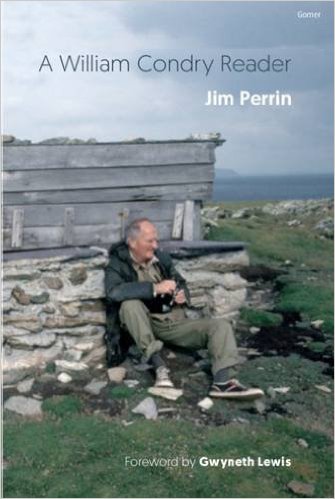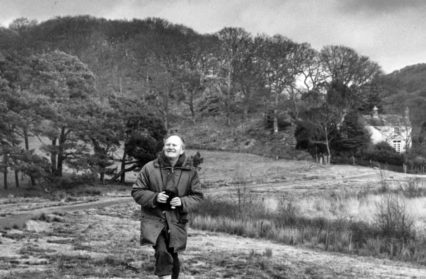Adam Somerset reviews A William Condry Reader by Jim Perrin consisting of selected writing about the relationship between readers and authors.
Gomer, 221 pp
Jim Perrin has grouped his selected writings of Bill Condry, composed over decades, into seven thematically linked sections. The result is an illustration of that alchemical relationship between reader and author, that sense of acquaintanceship outside barriers of time and place. Gwyneth Lewis provides a page of foreword. It was written, she says, in Vermont. She never met the author in person but came to know him in glimpses through reading. Condry’s book The Natural History of Wales, found in a Hay-on-Wye bookshop, was her first introduction. Researching an opera for children she read the minutes of the Kite Committee. Condry would attend its meetings, his journey from Ponterwyd to Rhandirmwyn made by bicycle. To know what that entails requires attention to the landscape. Gwyneth Lewis celebrates attention, that quality that Simone Weill elevated in her spiritual writings: “William Condry’s attention to the world around him has shaped my sense of the Welsh landscape.” Underlining quite why such attention – “clarity and depth of field” – matters, she writes, “I see little distinction between the skills needed to be a good writer and a good naturalist.”
 Appropriately in a book about closeness of attention Gwyneth Lewis’ opening words identify her location of writing. She is “in the rainy Green Mountains of Vermont, Robert Frost country.” Jim Perrin too in the first line of his thirty-page introduction declares his place of authorship. He is in “a foothills valley of the Pyrenees.” To continue in this vein this piece is being written in the valley of the Aeron, twelve miles down river from the source. The greater part of A William Condry Reader is located five river valleys north. The Dyfi Valley is familiar terrain, not least as site for Ceredigion’s railway link to the greater world. But to view it via the eyes and words of Bill Condry is to have it unveiled as a terrain wholly new.
Appropriately in a book about closeness of attention Gwyneth Lewis’ opening words identify her location of writing. She is “in the rainy Green Mountains of Vermont, Robert Frost country.” Jim Perrin too in the first line of his thirty-page introduction declares his place of authorship. He is in “a foothills valley of the Pyrenees.” To continue in this vein this piece is being written in the valley of the Aeron, twelve miles down river from the source. The greater part of A William Condry Reader is located five river valleys north. The Dyfi Valley is familiar terrain, not least as site for Ceredigion’s railway link to the greater world. But to view it via the eyes and words of Bill Condry is to have it unveiled as a terrain wholly new.
In part this is due to a keenness of eye and ear. At a youth hostel outside Llanidloes the sound of the wind moves from sigh to roar. He hears the tawny owls, their hoot and shriek, but also further up the valley the rarer, and different, sound of a long-eared owl. The trees that protect the hostel are not just pines, but Corsican pines. The winds that have prompted their planting are westerly gales. Condry is a reminder of that axiom of Anthony Burgess: Words themselves are not enough; writers need to know about things.
Things of course are communicated via the words of their denotation. There is a small universe of words now lost to common knowledge and over and over Condry gives rhapsodic expression to lists of what he sees around him. Robert McFarlane’s most recent book has been the task to reclaim words drifting into darkness. His roaming across all the United Kingdom found “roak”, “snow-scart”, “dimpsey” and “wicker”, the last a Cheshire term for the goldfinch.
The words by contrast from Condry are those he knows from his inner knowledge. At Morfa Harlech in 1958 he sees “shelduck, a pintail drake, some pochard, a few coots, moorhens, a dabchick…there seems hardly room for such a crowd on so small a water.” “Hirlwm” he says, is an expressive word for “long bleakness.” It distinguishes “two sorts of spring: the prolonged, less unkind spring of the plain and the late-arriving, icy-fingered spring of the mountains.”
He grapples with terms in search of accuracy. Parish records are source for historical sighting of fauna but are inconsistent in their usage. A wild cat might be designated “cath wyllt”, sometimes plain “cath”, occasionally “cath fynydd”, more regularly “cath goed.” “All quite satisfactory,” writes the researcher-naturalist, “until we realise that any of these names were also used locally for martens, polecats and heaven knows what else.”
Condry’s association with humans, and human action, is rare and rarely approving. He falls in approvingly with George Borrow in the walking of Plynlimon. R S Thomas is in receipt of a bursary with a condition that it be spent on travel. The two, enraptured at the sighting of a Bonelli’s warbler, overlook a small sign of warning. “Next moment we were being arrested by a French military officer for spying.”
Nearer to home in 1973 thousands of oystercatchers are shot at Burry at the behest of the Secretary of State of Wales, their offence an unproven over-consumption of cockles. At Ynyshir in 1975 wildfowlers shoot carelessly and leave their prey wounded or with broken wings. The remaking of the Clywedog Valley is spectacular but has a chilly air to it. At least the makers of water for Birmingham made their dams with an eye on artistry. The works at Llyn Brianne are of gruesome plainness. “I heartily detest Brianne… especially as it has a loathsomeness of conifers around it.”
Perrin recalls the death of his friend and companion in Morriston Hospital aged eighty on the thirtieth of May 1998. He is of Condry’s world. He too in his first paragraph knows redstart, broomrape and red-backed shrike. “It is surely best to turn from sadness to living memories,” he writes and does so, recalling “a spring day under the great cliff of Clogwyn Du’r Arddu.” Condry shows Perrin “a boulder close to an old mine adit, one side of which was entirely covered in moss campion, the other with purple saxifrage; both in their full flowering glory.” Perrin in turn leads his friend to a ledge that he knows to be home for Lloydia serotina, the Snowden lily.
Perrin identifies the scholarship “lightly worn but of serious depth” – Condry had degrees from Birmingham, London and Aberystwyth. He locates the writing within a rich tradition that takes in, among diverse strands, Carew and Herrick , Jefferies and Williamson, Matthiessen and Schaller. Perrin even commends the Cormac McCarthy of The Crossing.
Perrin, “a writer’s writer” in the words of Jon Gower, is a stylist whose own prose rests on a powerful hexameter rhythm. Unsurprisingly he hails similar qualities in the Condry style. A piece on the Dyfi estuary comprises “a dream-like mastery of prose-rhythm here, an underlying metricality as smoothly flowing as the tide itself.”
Perrin sketches the biography and the influences lightly. Non-conformity is to the fore. Condry’s mother attended the same meeting-house of the Society of Friends to which my mother would take her family on a Christmas morning. The strand of socialism was that of Robert Blatchford and his weekly publication The Clarion. Membership was of the Independent Labour Party. The Clent Hills were the nearest to the childhood home. Holidays took the form of camping for weeks on end in the shadow of the Rhinogs. The result: “it is out of doors that I have always felt most at ease.”
In the Condry Archive at the National Library Perrin reads a notebook entry written by the then sixteen year old. He descries even at that age the echo of Thoreau. Thoreau himself is cited by Condry in 1954: “We need the tonic of wildness… we require that all things be mysterious and unexplorable… we can never have enough of nature.”











